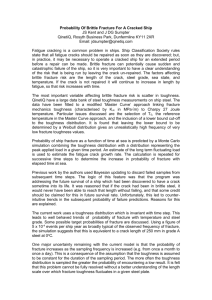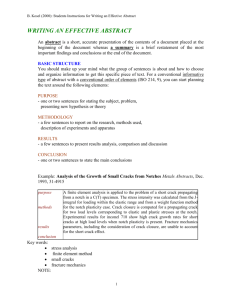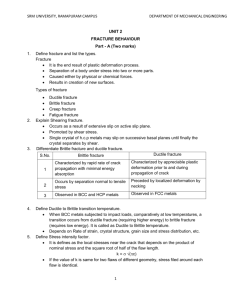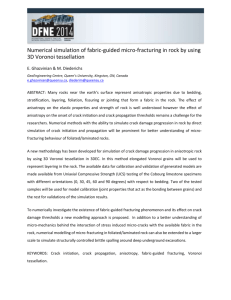Failure - Fog.ccsf.edu
advertisement
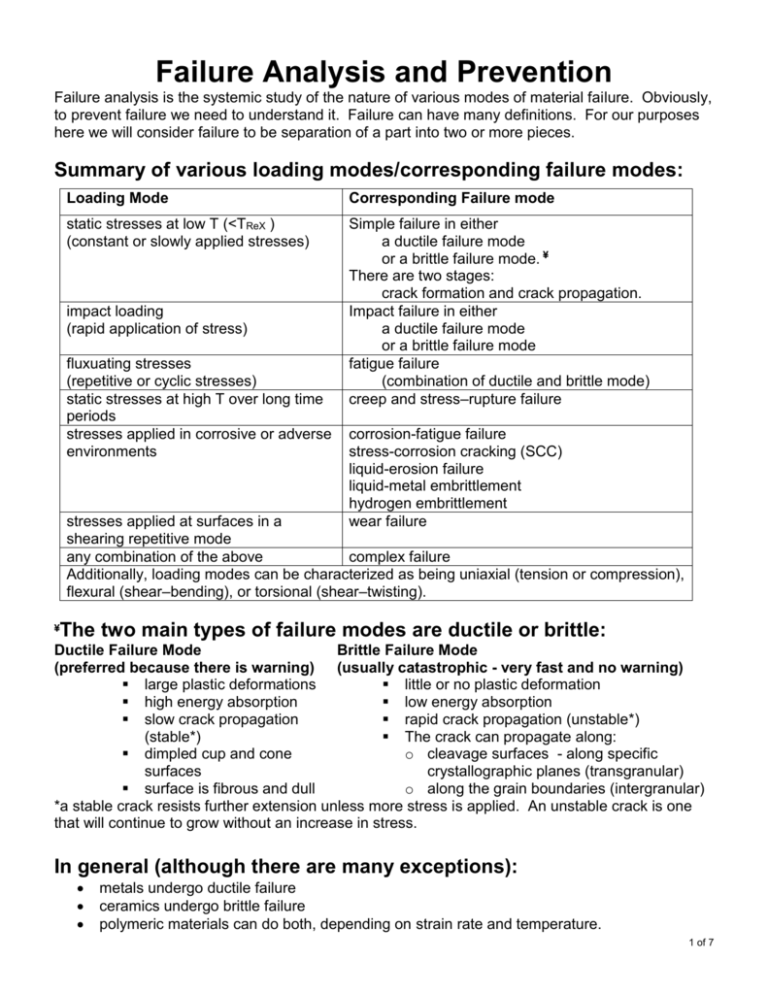
Failure Analysis and Prevention Failure analysis is the systemic study of the nature of various modes of material failure. Obviously, to prevent failure we need to understand it. Failure can have many definitions. For our purposes here we will consider failure to be separation of a part into two or more pieces. Summary of various loading modes/corresponding failure modes: Loading Mode Corresponding Failure mode static stresses at low T (<TReX ) (constant or slowly applied stresses) Simple failure in either a ductile failure mode or a brittle failure mode. ¥ There are two stages: crack formation and crack propagation. Impact failure in either a ductile failure mode or a brittle failure mode fatigue failure (combination of ductile and brittle mode) creep and stress–rupture failure impact loading (rapid application of stress) fluxuating stresses (repetitive or cyclic stresses) static stresses at high T over long time periods stresses applied in corrosive or adverse environments corrosion-fatigue failure stress-corrosion cracking (SCC) liquid-erosion failure liquid-metal embrittlement hydrogen embrittlement wear failure stresses applied at surfaces in a shearing repetitive mode any combination of the above complex failure Additionally, loading modes can be characterized as being uniaxial (tension or compression), flexural (shear–bending), or torsional (shear–twisting). The two main types of failure modes are ductile or brittle: ¥ Ductile Failure Mode Brittle Failure Mode (preferred because there is warning) (usually catastrophic - very fast and no warning) large plastic deformations little or no plastic deformation high energy absorption low energy absorption slow crack propagation rapid crack propagation (unstable*) (stable*) The crack can propagate along: dimpled cup and cone o cleavage surfaces - along specific surfaces crystallographic planes (transgranular) surface is fibrous and dull o along the grain boundaries (intergranular) *a stable crack resists further extension unless more stress is applied. An unstable crack is one that will continue to grow without an increase in stress. In general (although there are many exceptions): metals undergo ductile failure ceramics undergo brittle failure polymeric materials can do both, depending on strain rate and temperature. 1 of 7 Impact Fracture Testing Tensile tests are inadequate to predict fracture behavior under certain conditions: 1. low temperature 2. high strain rates 3. tri-axial stress states Under these conditions sometimes normally ductile metals fail in a brittle mode. Impact tests were developed for these “bad” cases. The two most common are the Charpy Impact Energy test and the Izod Impact Energy test. Both these tests measure the material property of impact energy (or notch toughness) which is merely the energy absorbed by a standard notched specimen while it underwent loading that produced a rapid succession of elastic deformation, plastic deformation and finally fracture. This material property is correlated to the toughness - the area under the stress-strain curve. (The difference between the Izod and the Charpy test is the geometry of the notch.) The material properties of impact energy and toughness are more “qualitative” than fracture toughness which was developed later in fracture mechanics. They are inadequate for design purposes; however, they do give some indication of how the material will respond. Ductile to Brittle Transition Temperature The Impact Energy tests revealed that many materials with the bcc or hcp structures experience a transition from ductile to brittle failure modes at low temperatures. fcc materials do not. This ductile to brittle transition temperature is dependant on the material composition (steels with more carbon have higher Tdb) and the microstructure (smaller grain materials have lower Tdb). 2 of 7 Fatigue is the failure of materials subjected to repetitive or cyclic stresses that can be much less than Sy. Fatigue failure is thought to be responsible for 90% metal failures. The fatigue stresses can be axial (T or C), flexural (bending), or torsional (twisting). The repeated applications of loads create local plastic deformations which result in a flaw, usually at the material’s surface. The flaw grows into a crack which then starts to grow with every cycle of stress. Once the crack grows to a size that becomes unstable, failure occurs quickly. Failure from fatigue can be catastrophic, sudden and without warning. The fatigue fracture surface tends to be largely brittle-like, even for normally ductile materials. Terms to quantify the stress applications: reversed stress – alternates between tensile and compressive loading repeated stress – repeatedly loads a stress (C or T) and then removes it mean stress, m =(max+min)/2 range of stress, r =(max-min) stress amplitude, a =range/2 stress ratio, R = min/max (can be negative) The RR Moore Test is the standard test used to quantify fatigue. The test will produce S-N curves where S is the applied stress for complete reversed loading (the worst case) and N is the number of cycles to failure S fatigue strength (endurance limit) (for ferrous alloys .35 -.60% TS) S1 fatigue strength (for specific number of cycles) Fatigue Life 106 -108 (for stress level S1) log N 3 of 7 4 of 7 Note: There are actually lots of “scatter” in the data for these curves since fatigue life will depend on many variables: fabrication methods surface preparations (case hardening by shot peening, carburizing or nitriding will increase the fatigue resistance) metallurgical variables specimen alignment in testing apparatus mean stress frequency of stress environment (thermal fatigue and corrosive fatigue) The fatigue mechanism: 1. Crack Initiation Crack originates at some point of high stress concentration such as a scratch, fillet, keyway, thread, dent, corner or micro flaw. 2. Crack Propagation Stage I. Ductile and smooth propagation of crack Stage II. Crack reaches critical size and the crack propagation rate increases. The direction of the crack propagation may change to be the stress. 3. Failure Failure occurs rapidly when remaining cross section can no longer carry the load. Number of cycles to failure is Nf = Ni + Np where i is the crack initiation phase and p is the crack propagation phase. So once a material has a crack, the crack will inevitably grow under cyclic stresses and failure will result. Fracture mechanics can be used to predict the “life” left. (i.e. the number of cycles left to failure.) Static Fatigue Fatigue in metals results from microstructural damage generated by a mechanical mechanism: cyclic loading. The same phenomena is found in polymers. Fatigue in ceramics and glasses results from microstructural damage generated by a different mechanism: chemical reactions. Since there is no cyclic loading, this phenomena is called static fatigue. It occurs in a moist environment at room temperature. The mechanism is a chemical reaction of water with the silicate network that generates two Si-OH unit that are not bonded to each other, leaving a break in the silicate network. 5 of 7 Fracture Mechanics is the theoretical and experimental analysis of the fracture of materials with pre-existing flaws. This field allows quantification of the relationships between material properties, stress level, the presence of crack-producing flaws, and crack propagation mechanisms. There are 3 modes of loading considered in Fracture Mechanics: Mode I – tensile (shown here) Mode II – shear Mode III – torsional Based on atomic bonding energies, the theoretical cohesive strength (fracture strength) of a material is on the order of E/10. However, the measured fracture strength of a brittle material is much lower. Why? The answer lies in the fact that there are small, microscopic flaws or cracks exist that act as stress raisers. The same phenomena is observed for any material with a crack. It will fail at stress levels below the expected strength for that material. stress raisers A stress raiser is anything that increases the nominal stress in a part, usually due to geometry. (Notches, keyways, corners, cracks, etc.) stress concentration factor, Kt This gives the factor by which the applied stress is multiplied to get the maximum stress at a stress raiser. Kt = m / o Stress concentration factors can be looked up for many different stress raisers and many different geometries. The Griffiths crack model predicted that the applied stress (o) is amplified or concentrated at the crack tip according to this equation: a m = 2 o t So the stress concentration factor for a crack is: Kt = m = 2 o a t Note: The stress concentration factors can be less in ductile materials because yielding leads to more uniform distribution of stress and a larger radius of curvature at the crack tip. stress intensity factor, K This is a parameter used in fracture mechanics that gives an indication of the material condition relative to the applied stress and the crack length: K = Yo a (units: MPa mm or psi in ) where o is the applied stress a is the crack length (= ½ crack length for an internal crack) Y is a function of crack length, geometry and manner of loading (usually 1.0) 6 of 7 fracture toughness, KC The fracture toughness is an important material property from the field of fracture mechanics. It is the critical value of the stress intensity factor that causes failure. Hence, it is a measure of the material’s resistance to brittle fracture when a crack is present. It can be thought of as the ductility of the material on a microscopic level. It will depend on temperature, strain rate and microstructure. fracture toughness, KIC The value for fracture toughness is usually given for mode I loading and plane strain. Then it is called “kay-one-cee”. plane strain A state of stress induced in the material when the plate thickness >>>crack length Generally plane strain applies if thickness > 2.5(KIC/y )2 plane stress The stress state for the case of a thin specimen. In this case K C will depend on the thickness. stress -vs- strength is analogous to stress intensity factor -vs- fracture toughness Life Calculations: Consider crack length, a -vs- number of cycles of stress, N: a 2 > 1 da = crack growth dN rate ao log (da/dN) I slow or no crack growth II III Power Law behavior Rapid (linear) Unstable da = A(K)m dN Crack Growth N Note: 1. small a small da/dN 2. as a increases so does da/dN 3. as stress increases so does da/dN In general da/dN = f (a,) Recall the stress intensity factor is also = f (a,) So we plot da/dN vs. K: K is the stress intensity factor range K = Kmax - Kmin = Y(max - min) a ) If Kmin is compressive, use 0 slope is m, extrapolated intercept is A log (K) this is Kth the threshold for the stress intensity factor range below this value there is no crack growth To get the life, Nf, for a particular value of a, integrate the power law equation between ao and af. ao is the value of the initial crack size and af can be found from the fracture toughness. This will only be approximate since the power law behavior is not valid over the entire life. 7 of 7


